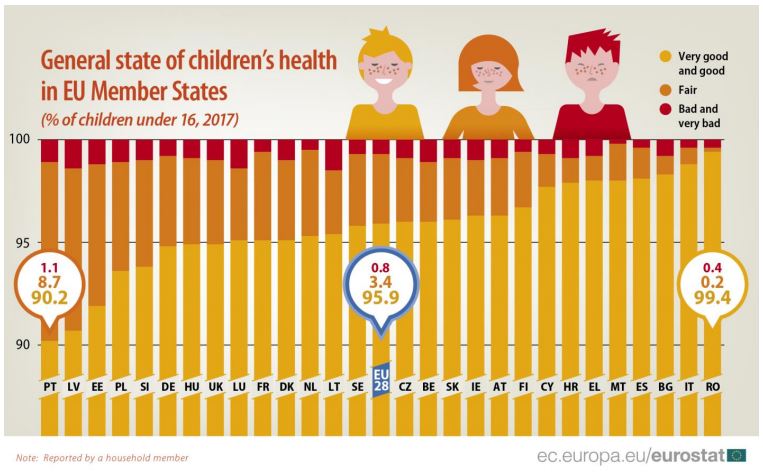In 2017, more than 95% of children in the European Union (EU) were considered to be in good or very good general health. This percentage changes only slightly by age group, from 96.5% for those aged under five, to
95.9% for those aged five to nine and 95.2% for those aged ten to fifteen. The percentage of children whose general health was considered to be bad or very bad was under 1% for all age groups.
Less than 5% of children in the EU in 2017 were considered to have limitations in activities due to health problems: 3.7% with moderate limitations and 1.2% with severe limitations. The proportion facing each category of limitations in activity increases with age. Among those aged under five, 2.2% had moderate and 0.6% had severe limitations in activities, while for those aged five to nine the proportions were 4.1% and 1.2% respectively and 4.4% and 1.6% for those aged ten to fifteen.

More than 99% of children under five in good health in Bulgaria, Malta, Romania and Italy
In 2017, the percentage of children aged under five considered to be in good or very good health ranged from 92.4% in Estonia to more than 99% in Bulgaria, Malta, Romania and Italy. Among children aged five to nine, the proportion of those considered to be in good or very good health was lowest in Portugal (89.3%) and Latvia (91.2%) and highest in Romania (99.8%), Cyprus (98.9%), Italy (98.8%) and Greece (98.7%).
Among those aged ten to fifteen, the percentage considered to be in good or very good health varied from below 90% in Latvia (88.0%), Portugal (88.7%) and Estonia (89.6%) to above 98% in Romania (99.1%), Italy (98.4%) and Bulgaria (98.2%)
In nearly all Member States, less than 1% of children under five have severe limitations in activity due to health problems
In 2017, among children aged under five, the percentage considered to have severe limitations in activity due to health problems was under 1% in all Member States except the United Kingdom (1.1%), Belgium (1.4%), Finland (1.5%) and Austria (1.6%). For moderate limitations in activity there was greater variation between Member States, ranging from less than 1% in Italy (0.2%), Cyprus (0.6%), Malta (0.7%) and Bulgaria (0.9%) to 4.9% in Denmark, 7.8% in Lithuania, 8.6% in Latvia.
For children aged five to nine, the proportion with severe limitations in activity was highest in the United Kingdom (3.7%), Denmark (2.4%), Luxembourg (2.3%) and Hungary (2.2%), and lowest in Italy and Bulgaria (both 0.3%). Moderate limitations in activity ranged from 0.2% in Italy and 0.9% in Greece to 7.9% in Finland, 8.3% in Lithuania, 8.4% in Estonia and 11.9% in Latvia.
Among those aged ten to fifteen, proportions with severe limitations in activity ranged from 0.1% in Lithuania to 2.9% in Luxembourg and 4.7% in the United Kingdom, while moderate limitations varied between 0.7% in Slovakia and 0.8% in Italy and Cyprus to 10.9% in Denmark, 11.4% in Finland and 13.5% in Latvia.
Geographical information
The European Union (EU) includes Belgium, Bulgaria, Czechia, Denmark, Germany, Estonia, Ireland, Greece, Spain, France, Croatia, Italy, Cyprus, Latvia, Lithuania, Luxembourg, Hungary, Malta, the Netherlands, Austria, Poland, Portugal, Romania, Slovenia, Slovakia, Finland, Sweden and the United Kingdom.
Methods and definitions
This News Release is based on the EU-Statistics on Income and Living Conditions (EU-SILC) ad hoc module 2017. The EUSILC survey is the EU reference source for comparative statistics on income distribution, poverty and living conditions.
The reference population is all private households and their current members residing in the territory of a given Member State at the time of data collection. Persons living in collective households and in institutions are generally excluded from the target population as well as small and remote parts of the national territory amounting to no more than 2% of the national population. The information on general health and limitation in activities due to health problems was provided for each child aged 0-15 by personal interview with the household respondent.
For more information
Eurostat website section on income, social inclusion and living conditions. Eurostat website section on EU-SILC ad-hoc modules
Eurostat database on income and living conditions